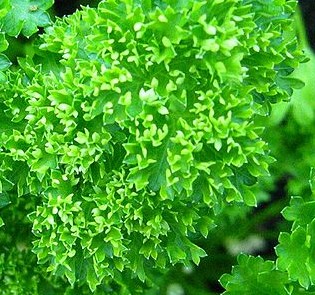 Parsley (Petroselinum crispum) is a biennial native to the Mediterranean area. It grows wild from Sardinia east to Lebanon but is cultivated throughout the temperate zones. It belong to the Apiaceae family so is related to carrot, celery, cilantro, and poison hemlock. During the first year it produces a rosette of bright green leaves four to ten inches long and a substantial taproot, then dies for the winter. In spring growth begins again and the plant assumes a height up to 1.5 feet. It produces new leaves and a flowering stem with an umbel composed of numerous tiny greenish yellow, five petaled flowers. The seeds are small, have a thick seed coat, and can take up to six weeks to germinate. Two varieties of parsley are commonly grown; Italian with flat leaves, and curly with frilly leaves. Parsley likes full sun, and fertile, moist well-drained soil. It is hardy in USDA zones 3-9.
Parsley (Petroselinum crispum) is a biennial native to the Mediterranean area. It grows wild from Sardinia east to Lebanon but is cultivated throughout the temperate zones. It belong to the Apiaceae family so is related to carrot, celery, cilantro, and poison hemlock. During the first year it produces a rosette of bright green leaves four to ten inches long and a substantial taproot, then dies for the winter. In spring growth begins again and the plant assumes a height up to 1.5 feet. It produces new leaves and a flowering stem with an umbel composed of numerous tiny greenish yellow, five petaled flowers. The seeds are small, have a thick seed coat, and can take up to six weeks to germinate. Two varieties of parsley are commonly grown; Italian with flat leaves, and curly with frilly leaves. Parsley likes full sun, and fertile, moist well-drained soil. It is hardy in USDA zones 3-9.
Shakespeare mentions parsley in Taming of the Shrew (act iv, sc. 4, 99). The servant, Biondello, when explaining his plan for an elopement, says to his young master, Lucentio;
I knew a wench married in an afternoon as she went to the garden for parsley to stuff a rabbit,
Parsley has been around at least since ancient times. Homer mentions its use for making chariot horses more fleet before battle. According to myth parsley sprung from the blood of Archemorus whose name meant “forerunner of death”. As a result the Greeks hung wreaths of the herb on grave sites and used it for the victory crowns of funerary athletic contests. The Romans wore parsley garlands on their heads to avoid intoxication and used it to for wreaths at weddings to ward off evil spirits. The Roman naturalist, Pliny the Elder (23-79 AD), notes the curled variety and mentions the use of parsley for sauces and broths and as a cure for sick fish. In the Middle Ages parsley was considered a cure for a wide range of human ills, especially those having to do with the liver and kidneys. It long germination time of was thought to be due to the fact that it had to go to the devil seven times before it grew. The Frankish king, Charlemagne (c742-814 AD) likde his cheese flavored with parsley seed. In the Renaissance parsley was thought to cure baldness and Henry VIII liked it as a seasoning for rabbit. The botanist John Gerard, contemporary of Shakespeare, knew of both curly and flat leaf parsley.
The generic name, Petroselinum, comes from the Greek words petros meaning rock, and selinuon meaning parsley. The specific name , crispum, means “closely curled” in Latin.